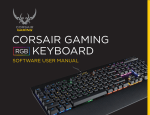Download User Guide - B&H Photo Video Digital Cameras, Photography
Transcript
User Guide © Copyright 2015 Hewlett-Packard Development Company, L.P. Bluetooth is a trademark owned by its proprietor and used by Hewlett-Packard Company under license. Intel is a trademark of Intel Corporation in the U.S. and other countries. Microsoft and Windows are U.S. registered trademarks of the Microsoft group of companies. The information contained herein is subject to change without notice. The only warranties for HP products and services are set forth in the express warranty statements accompanying such products and services. Nothing herein should be construed as constituting an additional warranty. HP shall not be liable for technical or editorial errors or omissions contained herein. First Edition: March 2015 Document Part Number: 804231-001 Product notice Software terms This guide describes features that are common to most models. Some features may not be available on your computer. By installing, copying, downloading, or otherwise using any software product preinstalled on this computer, you agree to be bound by the terms of the HP End User License Agreement (EULA). If you do not accept these license terms, your sole remedy is to return the entire unused product (hardware and software) within 14 days for a full refund subject to the refund policy of your seller. Not all features are available in all editions of Windows. This computer may require upgraded and/or separately purchased hardware, drivers and/or software to take full advantage of Windows functionality. Go to http://www.microsoft.com for details. To access the latest user guide, go to http://www.hp.com/support, and select your country. Select Drivers & Downloads, and then follow the on-screen instructions. For any further information or to request a full refund of the price of the computer, please contact your seller. Safety warning notice WARNING! To reduce the possibility of heat-related injuries or of overheating the computer, do not place the computer directly on your lap or obstruct the computer air vents. Use the computer only on a hard, flat surface. Do not allow another hard surface, such as an adjoining optional printer, or a soft surface, such as pillows or rugs or clothing, to block airflow. Also, do not allow the AC adapter to come into contact with the skin or a soft surface, such as pillows or rugs or clothing, during operation. The computer and the AC adapter comply with the user-accessible surface temperature limits defined by the International Standard for Safety of Information Technology Equipment (IEC 60950). ENWW iii iv Safety warning notice ENWW Table of contents 1 Starting right ................................................................................................................................................ 1 Best practices ......................................................................................................................................................... 1 More HP resources ................................................................................................................................................. 2 2 Getting to know your computer ...................................................................................................................... 3 Finding your hardware and software information ................................................................................................ 3 Right side ............................................................................................................................................................... 4 Rear ........................................................................................................................................................................ 5 Display ................................................................................................................................................................... 6 Top ......................................................................................................................................................................... 7 Touchpad ............................................................................................................................................. 7 Lights ................................................................................................................................................... 8 Buttons and speakers ......................................................................................................................... 9 Keys ................................................................................................................................................... 10 Labels ................................................................................................................................................................... 11 3 Customizable keyboard ................................................................................................................................ 12 HP Keyboard Control ........................................................................................................................................... 12 Current settings ................................................................................................................................................... 13 User profiles ........................................................................................................................................................ 13 Programmable keys ............................................................................................................................................ 14 Lighting zones ..................................................................................................................................................... 15 Advanced keyboard settings ............................................................................................................................... 16 Keyboard shortcuts ........................................................................................................................... 17 Disable key assignments .................................................................................................................. 18 4 Connecting to a network .............................................................................................................................. 19 Connecting to a wireless network ....................................................................................................................... 19 Using the wireless controls ............................................................................................................... 19 Using the wireless button ............................................................................................... 19 Using HP Connection Manager (select models only) ..................................................... 20 Using operating system controls ................................................................................... 20 Sharing data and drives and accessing software ............................................................................. 20 Using a WLAN ..................................................................................................................................... 21 Using an Internet service provider ................................................................................. 21 Setting up a WLAN .......................................................................................................... 22 ENWW v Configuring a wireless router ......................................................................................... 22 Protecting your WLAN ..................................................................................................... 22 Connecting to a WLAN ..................................................................................................... 23 Using Bluetooth wireless devices ..................................................................................................... 23 5 Enjoying entertainment features .................................................................................................................. 24 Multimedia features ............................................................................................................................................ 24 Using the webcam ............................................................................................................................................... 25 Using audio .......................................................................................................................................................... 26 Connecting speakers ......................................................................................................................... 26 Connecting headphones and microphones ...................................................................................... 26 Testing your audio features .............................................................................................................. 26 Using video .......................................................................................................................................................... 26 Connecting video devices by using an HDMI cable ........................................................................... 27 Setting up HDMI audio .................................................................................................... 27 Connecting digital display devices by using a DisplayPort cable ..................................................... 28 Using Intel Wireless Display and Wireless Music (select models only) ............................................ 29 6 Navigating the screen .................................................................................................................................. 30 Using the touchpad and gestures ....................................................................................................................... 30 Scrolling ............................................................................................................................................. 31 2-finger pinch zoom .......................................................................................................................... 31 Rotating ............................................................................................................................................. 32 Flicking .............................................................................................................................................. 32 Using the keyboard and mouse ........................................................................................................................... 32 Using the keys ................................................................................................................................... 33 Using the action keys ...................................................................................................... 33 Using ALT GR key combinations ..................................................................................... 34 7 Using HP Performance Advisor ...................................................................................................................... 35 Managing BIOS with HP Performance Advisor .................................................................................................... 35 8 Managing power .......................................................................................................................................... 36 Initiating Sleep and Hibernation .......................................................................................................................... 36 Manually initiating and exiting Sleep ................................................................................................ 37 Manually initiating and exiting Hibernation (select models only) ................................................... 37 Setting password protection on wakeup .......................................................................................... 37 Using the power meter ........................................................................................................................................ 38 Selecting a power plan ........................................................................................................................................ 38 Running on battery power ................................................................................................................................... 38 vi ENWW Factory-sealed battery ..................................................................................................................... 38 Finding battery information .............................................................................................................. 39 Conserving battery power ................................................................................................................. 39 Identifying low battery levels ........................................................................................................... 39 Resolving a low battery level ............................................................................................................ 39 Resolving a low battery level when external power is available .................................. 39 Resolving a low battery level when no power source is available ................................ 39 Resolving a low battery level when the computer cannot exit Hibernation ................. 40 Running on external AC power ............................................................................................................................ 40 Troubleshooting power problems .................................................................................................... 40 Refreshing your software content with Intel Smart Connect Technology (select models only) ....................... 41 Shutting down the computer .............................................................................................................................. 42 9 Maintaining your computer .......................................................................................................................... 43 Improving performance ....................................................................................................................................... 43 Handling drives .................................................................................................................................. 43 Using Disk Cleanup ............................................................................................................................ 43 Updating programs and drivers .......................................................................................................................... 44 Cleaning your computer ...................................................................................................................................... 44 Cleaning procedures ......................................................................................................................... 44 Cleaning the display ........................................................................................................ 44 Cleaning the sides or cover ............................................................................................. 44 Cleaning the touchpad, keyboard, or mouse ................................................................. 45 Traveling with or shipping your computer .......................................................................................................... 45 10 Securing your computer and information ..................................................................................................... 47 Locating your security software ......................................................................................................................... 47 Using passwords .................................................................................................................................................. 47 Setting Windows passwords ............................................................................................................. 48 Setting Setup Utility (BIOS) passwords ............................................................................................ 48 Using Internet security software ......................................................................................................................... 49 Using antivirus software ................................................................................................................... 49 Using firewall software ..................................................................................................................... 49 Installing software updates ................................................................................................................................ 49 Installing critical security updates .................................................................................................... 49 Installing HP and third-party software updates .............................................................................. 50 Securing your wireless network .......................................................................................................................... 50 Backing up your software applications and information ................................................................................... 50 ENWW vii 11 Using Setup Utility (BIOS) and HP PC Hardware Diagnostics (UEFI) ................................................................. 51 Starting Setup Utility (BIOS) ................................................................................................................................ 51 Updating the BIOS ................................................................................................................................................ 51 Determining the BIOS version ........................................................................................................... 51 Downloading a BIOS update .............................................................................................................. 51 Using HP PC Hardware Diagnostics (UEFI) .......................................................................................................... 52 Downloading HP PC Hardware Diagnostics (UEFI) to a USB device .................................................. 53 12 Backing up, restoring, and recovering ......................................................................................................... 54 Creating backups ................................................................................................................................................. 54 Creating recovery media to recover the original system ................................................................. 54 What you need to know .................................................................................................. 54 Creating the recovery media ........................................................................ 54 Creating system restore points ........................................................................................................ 55 What you need to know .................................................................................................. 55 Creating a system restore point ..................................................................................... 55 Backing up system and personal information .................................................................................. 55 Tips for a successful backup ........................................................................................... 55 What you need to know .................................................................................................. 56 Creating a backup using Windows Backup and Restore ................................................ 56 Restore and recovery .......................................................................................................................................... 57 Restoring to a previous system restore point .................................................................................. 57 Restoring specific files ...................................................................................................................... 57 Restoring specific files using Windows Backup and Restore ......................................... 57 Recovering the original system using HP Recovery Manager .......................................................... 57 What you need to know .................................................................................................. 57 Recovering using HP Recovery partition (select models only) ...................................... 58 Recovering using the recovery media ............................................................................ 58 Changing the computer boot order .............................................................. 58 13 Specifications ........................................................................................................................................... 59 Input power .......................................................................................................................................................... 59 Operating environment ....................................................................................................................................... 59 14 Electrostatic Discharge .............................................................................................................................. 60 Index ............................................................................................................................................................. 61 viii ENWW 1 Starting right Best practices After you set up and register the computer, we recommend the following steps to get the most out of your smart investment: ENWW ● If you haven’t already done so, connect to a wired or wireless network. See details in Connecting to a network on page 19. ● Become familiar with the computer hardware and software. Go to Getting to know your computer on page 3 and Enjoying entertainment features on page 24 for information. ● Update or purchase antivirus software. Learn more at Using antivirus software on page 49. ● Back up your hard drive by creating recovery discs or a recovery flash drive. See Backing up, restoring, and recovering on page 54. Best practices 1 More HP resources You have already used Setup Instructions to turn on the computer and locate this guide. For product details, how-to information, and more, use this table. Resource Contents Setup Instructions ● Overview of computer setup and features. Help and Support ● A broad range of how-to information and troubleshooting tips. Worldwide support ● Chat online with an HP technician To get support in your language, go to http://welcome.hp.com/country/us/en/ wwcontact_us.html. ● Support telephone numbers ● HP service center locations Safety & Comfort Guide ● Proper workstation setup To access this guide, select Start > HP Support Assistant > Next > My computer > User Guides. ● Guidelines for posture and work habits that increase your comfort and decrease your risk of injury – or – ● Electrical and mechanical safety information ● Important regulatory notices ● Specific warranty information about this computer To access Help and Support, select Start > Help and Support. For U.S. support, go to http://www.hp.com/go/ contactHP. For worldwide support, go to http://welcome.hp.com/country/us/en/ wwcontact_us.html. Go to http://www.hp.com/ergo. Regulatory, Safety and Environmental Notices To access this guide, select Start > HP Support Assistant > Next > My computer > User Guides. Limited Warranty* To access this guide, select Start > HP Support Assistant > Next > My computer > User Guides. – or – Go to http://www.hp.com/go/orderdocuments. *You can find the expressly provided HP Limited Warranty applicable to your product located with the user guides on your computer and/or on the CD/DVD provided in the box. In some countries/regions, HP may provide a printed HP Limited Warranty in the box. For countries/regions where the warranty is not provided in printed format, you may request a printed copy from http://www.hp.com/go/ orderdocuments or write to: ● North America: Hewlett-Packard, MS POD, 11311 Chinden Blvd., Boise, ID 83714, USA ● Europe, Middle East, Africa: Hewlett-Packard, POD, Via G. Di Vittorio, 9, 20063, Cernusco s/Naviglio (MI), Italy ● Asia Pacific: Hewlett-Packard, POD, P.O. Box 200, Alexandra Post Office, Singapore 911507 When you request a printed copy of your warranty, please include your product number, warranty period (found on your service label), name, and postal address. IMPORTANT: Do NOT return your HP product to the addresses above. For U.S. support, go to http://www.hp.com/go/contactHP. For worldwide support, go to http://welcome.hp.com/country/us/en/wwcontact_us.html. 2 Chapter 1 Starting right ENWW 2 Getting to know your computer Finding your hardware and software information ▲ Select Start > Computer. – or – ▲ Select Start > All Programs > HP > HP Performance Advisor > Your Computer > Device Information. A list displays all the devices installed in your computer, including optical drives, solid-state drives (SSD), or a secondary hard drive. To find out what software is included on your computer, select Start > All Programs. ENWW Finding your hardware and software information 3 Right side Component (1) Description Memory card reader Reads optional memory cards that store, manage, share, or access information. To insert a card: Hold the card label-side up, with connectors facing the slot, insert the card into the slot, and then press in on the card until it is firmly seated. To remove a card: Press in on the card it until it pops out. 4 Chapter 2 Getting to know your computer ENWW Rear Component (1) Description Vents (2) Enable airflow to cool internal components. NOTE: The computer fan starts up automatically to cool internal components and prevent overheating. It is normal for the internal fan to cycle on and off during routine operation. (2) AC adapter light ● On: The AC adapter is connected and the battery is charged. ● Off: The computer is using battery power. (3) Power connector Connects an AC adapter. (4) USB 3.0 ports (4) Connect optional USB devices, such as a keyboard, mouse, external drive, printer, scanner or USB hub. NOTE: Your computer does not include a RJ-45 (network) jack. To connect to a wired network, you must use the USB Ethernet adapter provided. (5) HDMI port Connects an optional video or audio device, such as a highdefinition television, any compatible digital or audio component, or a high-speed HDMI device. (6) Mini DisplayPort Connects an optional digital display device, such as a highperformance monitor or projector. NOTE: You can connect up to 2 optional display devices with a Mini DisplayPort splitter (purchased separately). (7) Audio-out (headphone)/Audio-in (microphone) jack Connects optional powered stereo speakers, headphones, earbuds, a headset, or a television audio cable. Also connects an optional headset microphone. This jack does not support optional microphone-only devices. WARNING! To reduce the risk of personal injury, adjust the volume before putting on headphones, earbuds, or a headset. For additional safety information, refer to the Regulatory, Safety, and Environmental Notices. NOTE: When a device is connected to the jack, the computer speakers are disabled. NOTE: Be sure that the device cable has a 4-conductor connector that supports both audio-out (headphone) and audioin (microphone). ENWW Rear 5 Display Component Description (1) WLAN antennas* Send and receive wireless signals to communicate with wireless local area networks (WLANs). (2) Internal microphones (2) Record sound. (3) Webcam light On: The webcam is in use. (4) Webcam Records video and captures photographs. Some models allow you to video conference and chat online using streaming video. To use the webcam, select Start > All Programs > Communication and Chat > HP WebCam. (5) Internal display switch Turns off the display and initiates Sleep if the display is closed while the power is on. NOTE: The internal display switch is not visible from the outside of the computer. *The antennas are not visible from the outside of the computer. For optimal transmission, keep the areas immediately around the antennas free from obstructions. For wireless regulatory notices, see the section of the Regulatory, Safety, and Environmental Notices that applies to your country or region. To access this guide, select Start > HP Support Assistant > Next > My computer > User Guides. 6 Chapter 2 Getting to know your computer ENWW Top Touchpad Component (1) Description Touchpad zone Reads your finger gestures to move the pointer or activate items on the screen. TIP: You can disable the touchpad or change the touchpad sensitivity and click speed. See Keyboard shortcuts on page 17 and Using the touchpad and gestures on page 30 for more information. ENWW (2) Left touchpad button Functions like the left button on an external mouse. (3) Right touchpad button Functions like the right button on an external mouse. Top 7 Lights TIP: You can customize the keyboard lighting. See Lighting zones on page 15. Component (1) Power light ● On: The computer is on. ● Blinking: The computer is in the Sleep state, a powersaving state. The computer shuts off power to the display and other unneeded components. ● Off: The computer is off or in Hibernation. Hibernation is a power-saving state that uses the least amount of power. (2) Caps lock light On: Caps lock is on, which switches the keys to all capital letters. (3) Mute light ● Amber: Computer sound is off. ● Off: Computer sound is on. ● Off: An integrated wireless device, such as a wireless local area network (WLAN) device and/or a Bluetooth® device, is on. ● Amber: All wireless devices are off. (4) 8 Description Wireless light Chapter 2 Getting to know your computer ENWW Buttons and speakers Component (1) Description Power button ● When the computer is off, press the button to turn on the computer. ● When the computer is on, press the button briefly to initiate Sleep. ● When the computer is in the Sleep state, press the button briefly to exit Sleep. ● When the computer is in Hibernation, press the button briefly to exit Hibernation. CAUTION: Pressing and holding down the power button will result in the loss of unsaved information. If the computer has stopped responding and Windows® shutdown procedures are ineffective, press and hold the power button down for at least 5 seconds to turn off the computer. To learn more about your power settings, select Start > Control Panel > System and Security > Power Options, or see Managing power on page 36. (2) ENWW Speakers (2) Produce sound. Top 9 Keys TIP: You can customize these keys in HP Keyboard Control. See Advanced keyboard settings on page 16. Component Description (1) Programmable keys Allow you to create up to 30 different customized key combinations when used alone or with the fn, ctrl, alt, or shift keys. See Programmable keys on page 14 for more information. (2) esc key Displays system information when pressed in combination with the fn key. (3) fn key Executes frequently used system functions when pressed in combination with one of the action keys or the esc key. (4) Windows key Displays the Windows Start menu. TIP: You can disable the Windows key in HP Keyboard Control. See Disable key assignments on page 18. (5) Action keys Execute frequently used system functions when pressed in combination with the fn key. NOTE: On select models, the fn+f5 action key turns the keyboard backlight feature off or on. (6) Windows application key Displays options for a selected object. TIP: You can disable the Windows application key in HP Keyboard Control. See Disable key assignments on page 18. 10 Chapter 2 Getting to know your computer ENWW Labels The labels affixed to the computer provide information you may need when you troubleshoot system problems or travel internationally with the computer. IMPORTANT: All labels described in this section will be located in one of 3 places depending on your computer model: affixed to the bottom of the computer, located in the battery bay, or under the service door. TIP: You can also press fn+esc for system information. ● Service label—Provides important information to identify your computer. When contacting support, you will probably be asked for the serial number, and possibly for the product number or the model number. Locate these numbers before you contact support. Your service label will resemble one of the examples shown below. Refer to the illustration that most closely matches the service label on your computer. Component ● (1) Serial number (2) Product number (3) Warranty period (4) Model number (select models only) Microsoft® Certificate of Authenticity label (select models only prior to Windows 8)—Contains the Windows Product Key. You may need the Product Key to update or troubleshoot the operating system. HP platforms preinstalled with Windows 8 or Windows 8.1 do not have the physical label, but have a Digital Product Key electronically installed. NOTE: This Digital Product Key is automatically recognized and activated by Microsoft Operating Systems on a reinstall of the Windows 8 or Windows 8.1 operating system with HP-approved recovery methods. ENWW ● Regulatory label(s)—Provide(s) regulatory information about the computer. ● Wireless certification label(s)—Provide(s) information about optional wireless devices and the approval markings for the countries or regions in which the devices have been approved for use. Labels 11 3 Customizable keyboard Your computer includes a highly customizable keyboard with unique lighting effects. Create profiles and configure shortcuts and lighting for ultimate experience. NOTE: Keyboard macros are not supported. HP Keyboard Control HP Keyboard Control is a utility that allows you to customize your computer for your specific needs. With HP Keyboard Control, you can do the following: ● Create user profiles ● Program key assignments ● Customize the keyboard lighting ● Disable the touchpad or touch screen ● Turn fans to maximum speed ● Enable or disable current key assignments NOTE: Keyboard macros are not supported. To open HP Keyboard Control from the Windows desktop: ▲ 12 Click the HP Keyboard Control icon. Chapter 3 Customizable keyboard ENWW Current settings Current Settings in HP Keyboard Control shows you the current, active state of all the keyboard, lighting, and advanced settings. In Current Settings, you can view and change settings and they are instantly applied. To save current settings for future use: 1. From the Windows desktop, click the HP Keyboard Control icon. 2. Under Profiles, select Current Settings, and then make any necessary changes. 3. Click the Save icon, and then type the name of the new user profile. User profiles A user profile is a group of settings that can be customized and saved. You can create an unlimited number of profiles and assign up to 10 profiles at a time using the fn key + any one of the number keys. To create user profiles: 1. From the Windows desktop, click the HP Keyboard Control icon. 2. Under Profiles, click the + icon to create a user profile. 3. Type the name of the user profile. NOTE: Repeat steps 2 through 3 to create an unlimited number of user profiles. NOTE: Launch a saved user profile by pressing fn + the number key combination that you defined for that user profile. TIP: You can make changes to existing profiles and save them, or you can click Load Default to return the user profile to the default settings. ENWW Current settings 13 Programmable keys The keyboard has six programmable keys (1) with up to five different settings each. You can create a total of 30 different key combinations when used alone or with the fn, ctrl, alt, or shift keys. To program the keys: 1. From the Windows desktop, click the HP Keyboard Control icon. 2. Select the Key Assignments tab, and then click the box next to the key you want to program. 3. Type any key assignment that you want, and then assign it to a user profile. NOTE: 14 Repeat steps 2 through 3 for a total of 30 different combinations. Chapter 3 Customizable keyboard ENWW Lighting zones The keyboard includes programmable lighted keyboard zones that ensure that you hit the right key every time, even when working in low-light conditions. With HP Keyboard Control you can customize the colors of each zone for each user profile. NOTE: When you first set up your computer, all of the lighting zones are red. Component (1) Power button (2) Speakers (3) Programmable keys (4) Left zone (5) WASD keys (6) Center zone (7) Right zone (8) Fan NOTE: ENWW The fan color will always be red. Lighting zones 15 To customize the lighting zones for current settings or a user profile that you want to change: 1. From the Windows desktop, click the HP Keyboard Control icon. 2. Select the Lighting tab. 3. On the keyboard image, click the lighting zone you want to customize. –or– In the drop-down box, select the lighting zone that you want to customize. 4. Select the color you want to change, and then assign it to a user profile. NOTE: Repeat steps 2 through 4 for each lighting zone you want to change for each user profile. TIP: You can select one color and apply it to all the lighting zones at once. Advanced keyboard settings With advanced settings in HP Keyboard Control, you can have more control over your keyboard functions. You can disable keys on the keyboard as well as the touchpad and touch screen. 16 Chapter 3 Customizable keyboard ENWW Keyboard shortcuts There are three keyboard shortcuts that you can enable to customize your experience. A keyboard shortcut is a combination of the fn key (1) and either the f, r, or t key (2). NOTE: If you restart the computer, the touch screen features will turn back on, and the touchpad will be reenabled (unless a mouse is attached and that option is selected). Key combination Description fn+f Turns the computer fans on maximum speed. fn+r Turns the touchpad off and on. fn+t Turns the touch screen features off and on. To enable or disable the shortcut keys: 1. From the Windows desktop, click the HP Keyboard Control icon. 2. Click the Advanced tab. 3. Under Screen and Trackpad and System Settings, select the function you want to disable or enable. Some functions are always enabled. To use a shortcut key: ▲ ENWW Briefly press the fn key, and then briefly press the second key of the shortcut key combination. Advanced keyboard settings 17 Disable key assignments You can disable the Windows key, Caps Lock key, Windows application key, or any one of the action keys. To disable keys: 18 1. From the Windows desktop, click the HP Keyboard Control icon. 2. Select the Advanced tab. 3. Under Disable Keys and Function Key Defaults, select the key you want to disable. Chapter 3 Customizable keyboard ENWW 4 Connecting to a network Your computer can travel with you wherever you go. But even at home, you can explore the globe and access information from millions of websites using your computer and a wired or wireless network connection. This chapter will help you get connected to that world. NOTE: Your computer does not include a RJ-45 (network) jack. To connect to a wired network, you must use the USB Ethernet adapter provided. Connecting to a wireless network Wireless technology transfers data across radio waves instead of wires. Your computer may be equipped with one or more of the following wireless devices: ● Wireless local area network (WLAN) device—Connects the computer to wireless local area networks (commonly referred to as Wi-Fi networks, wireless LANs, or WLANs) in corporate offices, your home, and public places such as airports, restaurants, coffee shops, hotels, and universities. In a WLAN, the mobile wireless device in your computer communicates with a wireless router or a wireless access point. ● Bluetooth device (select models only)—Creates a personal area network (PAN) to connect to other Bluetooth-enabled devices such as computers, phones, printers, headsets, speakers, and cameras. In a PAN, each device communicates directly with other devices, and devices must be relatively close together—typically within 10 meters (approximately 33 feet) of each other. For more information about wireless technology, the Internet, and networking, see the information and website links provided in Help and Support. Select Start > Help and Support Using the wireless controls You can control the wireless devices in your computer using these features: ● Wireless button, wireless switch, or wireless key (referred to in this chapter as the wireless button) ● HP Connection Manager software ● Operating system controls Using the wireless button The computer has a wireless button, one or more wireless devices, and one wireless light. All the wireless devices on your computer are enabled at the factory, and if your computer has a wireless light, the wireless light is off when you turn on the computer. The wireless light indicates the overall power state of your wireless devices, not the status of individual devices. If the wireless light is off at least one wireless device is on. If the wireless light is amber, all wireless devices are off. Because the wireless devices are enabled at the factory, you can use the wireless button to turn on or turn off the wireless devices simultaneously. Individual wireless devices can be controlled through HP Connection Manager. ENWW Connecting to a wireless network 19 Using HP Connection Manager (select models only) HP Connection Manager provides a central location for managing your wireless devices, an interface for connecting to the Internet using HP Mobile Broadband, and an interface for sending and receiving SMS (text) messages. HP Connection Manager allows you to manage the following devices: ● Wireless local area network (WLAN)/Wi-Fi ● Wireless wide area network (WWAN)/HP Mobile Broadband ● Bluetooth HP Connection Manager provides information and notifications on connection status, power status, subscriber identity module (SIM) details, and SMS (text) messages. Status information and notifications are provided in the notification area, at the far right of the taskbar. To open HP Connection Manager, select Start > All Programs > HP Help and Support > HP Connection Manager. For more details about using HP Connection Manager, see the HP Connection Manager software Help. Using operating system controls The Network and Sharing Center allows you to set up a connection or network, connect to a network, manage wireless networks, and diagnose and repair network problems. To use operating system controls, select Start > Control Panel > Network and Internet > Network and Sharing Center. For more information, select Start > Help and Support. Sharing data and drives and accessing software When your computer is part of a network, you are not limited to using only the information that is stored in your computer. Network computers can exchange software and data with each other. NOTE: When a disc like a DVD movie or game is copy-protected, it cannot be shared. To share on the same network: 20 1. From the computer you are sharing, select Start > Computer. 2. Right-click what you want to share, and click Properties. 3. Select the Sharing tab, and then select Advanced Sharing. 4. Select the Share this folder check box. 5. Type a name in the Share name text box. 6. Click Apply, and then click OK. 7. To view the shared drive, select Start > Control Panel > Network and Internet > Network and Sharing Center. Chapter 4 Connecting to a network ENWW Using a WLAN With a WLAN device, you can access a wireless local area network (WLAN), which is composed of other computers and accessories that are linked by a wireless router or a wireless access point. NOTE: The terms wireless router and wireless access point are often used interchangeably. ● A large-scale WLAN, such as a corporate or public WLAN, typically uses wireless access points that can accommodate a large number of computers and accessories and can separate critical network functions. ● A home or small office WLAN typically uses a wireless router, which allows several wireless and wired computers to share an Internet connection, a printer, and files without requiring additional pieces of hardware or software. To use the WLAN device in your computer, you must connect to a WLAN infrastructure (provided through a service provider or a public or corporate network). Using an Internet service provider When you are setting up Internet access in your home, you must establish an account with an Internet service provider (ISP). To purchase Internet service and a modem, contact a local ISP. The ISP will help set up the modem, install a network cable to connect your wireless computer to the modem, and test the Internet service. NOTE: Your ISP will give you a user ID and a password to use for Internet access. Record this information and store it in a safe place. ENWW Connecting to a wireless network 21 Setting up a WLAN To set up a WLAN and connect to the Internet, you need the following equipment: ● A broadband modem (either DSL or cable) (1) and high-speed Internet service purchased from an Internet service provider ● A wireless router (2) (purchased separately) ● A wireless computer (3) NOTE: Some modems have a built-in wireless router. Check with your ISP to determine what type of modem you have. The illustration below shows an example of a wireless network installation that is connected to the Internet. As your network grows, additional wireless and wired computers can be connected to the network to access the Internet. For help in setting up your WLAN, see the information provided by your router manufacturer or your ISP. Configuring a wireless router For help in setting up a WLAN, see the information provided by your router manufacturer or your ISP. NOTE: It is recommended that you initially connect your new wireless computer to the router by using the network cable provided with the router. When the computer successfully connects to the Internet, disconnect the cable, and access the Internet through your wireless network. Protecting your WLAN When you set up a WLAN or access an existing WLAN, always enable security features to protect your network from unauthorized access. WLANs in public areas (hotspots) like coffee shops and airports may not provide any security. If you are concerned about the security of your computer in a hotspot, limit your network activities to email that is not confidential and basic Internet surfing. Wireless radio signals travel outside the network, so other WLAN devices can pick up unprotected signals. Take the following precautions to protect your WLAN: ● Use a firewall. A firewall checks both data and requests for data that are sent to your network, and discards any suspicious items. Firewalls are available in both software and hardware. Some networks use a combination of both types. ● Use wireless encryption. Wireless encryption uses security settings to encrypt and decrypt data that is transmitted over the network. For more information, see Help and Support. 22 Chapter 4 Connecting to a network ENWW Connecting to a WLAN To connect to the WLAN, follow these steps: 1. Be sure that the WLAN device is on. If the device is on, the wireless light is off. If the wireless light is amber, press the wireless button. 2. Click the network status icon in the notification area, at the far right of the taskbar. 3. Select your WLAN from the list. 4. Click Connect. If the WLAN is a security-enabled WLAN, you are prompted to enter a security code. Type the code, and then click OK to complete the connection. NOTE: If no WLANs are listed, you may be out of range of a wireless router or access point. NOTE: If you do not see the WLAN you want to connect to, click Open Network and Sharing Center, and then click Set up a new connection or network. A list of options is displayed, allowing you to manually search for and connect to a network or to create a new network connection. After the connection is made, place the mouse pointer over the network status icon in the notification area, at the far right of the taskbar, to verify the name and status of the connection. NOTE: The functional range (how far your wireless signals travel) depends on WLAN implementation, router manufacturer, and interference from other electronic devices or structural barriers such as walls and floors. Using Bluetooth wireless devices A Bluetooth device provides short-range wireless communications that replace the physical cable connections that traditionally link electronic devices such as the following: ● Computers (desktop, notebook, PDA) ● Phones (cellular, cordless, smart phone) ● Imaging devices (printer, camera) ● Audio devices (headset, speakers) ● Mouse Bluetooth devices provide peer-to-peer capability that allows you to set up a personal area network (PAN) of Bluetooth devices. For information about configuring and using Bluetooth devices, see the Bluetooth software Help. ENWW Connecting to a wireless network 23 5 Enjoying entertainment features Use your HP computer as an entertainment hub to socialize via the webcam, enjoy and manage your music, and download and watch movies. Or, to make your computer an even more powerful entertainment center, connect external devices like speakers, headphones, monitor, projector, TV, and, on select models, highdefinition devices. Multimedia features Here are some of the entertainment features on your computer. Component 24 Description (1) Internal microphones (2) Record sound. (2) Webcam light On: The webcam is in use. (3) Webcam Records video and captures photographs. Some models allow you to video conference and chat online using streaming video. Chapter 5 Enjoying entertainment features ENWW Component Description To use the webcam, select Start > All Programs > Communication and Chat > HP WebCam. (4) Speakers (2) Produce sound. (5) Memory card reader Reads optional memory cards that store, manage, share, or access information. To insert a card: Hold the card label-side up, with connectors facing the slot, insert the card into the slot, and then press in on the card until it is firmly seated. To remove a card: Press in on the card it until it pops out. (6) USB 3.0 ports (4) Connect optional USB devices, such as a keyboard, mouse, external drive, printer, scanner or USB hub. (7) HDMI port Connects an optional video or audio device, such as a highdefinition television, any compatible digital or audio component, or a high-speed HDMI device. (8) Mini DisplayPort Connects an optional digital display device, such as a highperformance monitor or projector. NOTE: You can connect up to 2 optional display devices with a Mini DisplayPort splitter (purchased separately). (9) Audio-out (headphone)/Audio-in (microphone) jack Connects optional powered stereo speakers, headphones, earbuds, a headset, or a television audio cable. Also connects an optional headset microphone. This jack does not support optional microphone-only devices. WARNING! To reduce the risk of personal injury, adjust the volume before putting on headphones, earbuds, or a headset. For additional safety information, refer to the Regulatory, Safety, and Environmental Notices. To access this guide, select Start > HP Support Assistant > Next > My computer > User guides. NOTE: When a device is connected to the jack, the computer speakers are disabled. NOTE: Be sure that the device cable has a 4-conductor connector that supports both audio-out (headphone) and audio-in (microphone). Using the webcam The computer has an integrated webcam that records video and captures photographs. Some models may allow you to video conference and chat online using streaming video. ▲ To start the webcam, select Start > All Programs > Communication and Chat > HP WebCam. For details about using the webcam, select Start > Help and Support. ENWW Using the webcam 25 Using audio On your computer, or on select models using an external optical drive, you can play music CDs, download and listen to music, stream audio content from the web (including radio), record audio, or mix audio and video to create multimedia. To enhance your listening enjoyment, attach external audio devices such as speakers or headphones. Connecting speakers You can attach wired speakers to your computer by connecting them to USB ports (or the audio-out jack) on your computer or on a docking station. To connect wireless speakers to your computer, follow the device manufacturer's instructions. To connect high-definition speakers to the computer, see Setting up HDMI audio on page 27. Before connecting audio devices, be sure to adjust the volume. Connecting headphones and microphones You can connect wired headphones or headsets to the audio-out (headphone)/audio-in (microphone) jack on your computer. Many headsets with integrated microphones are commercially available. To connect wireless headphones or headsets to your computer, follow the device manufacturer's instructions. WARNING! To reduce the risk of personal injury, lower the volume setting before putting on headphones, earbuds, or a headset. For additional safety information, see the Regulatory, Safety and Environmental Notices. To access this guide, select Start > HP Support Assistant > Next > My computer > User Guides. Testing your audio features To check the audio functions on your computer, follow these steps: 1. Select Start > Control Panel > Hardware and Sound > Sound. 2. When the Sound window opens, click the Sounds tab. Under Program Events, select any sound event, such as a beep or alarm, and click the Test button. To check the recording functions on your computer, follow these steps: 1. Select Start > All Programs > Accessories > Sound Recorder. 2. Click Start Recording and speak into the microphone. 3. Save the file to your desktop. 4. Open a multimedia program and play the recording. To confirm or change the audio settings on your computer, select Start > Control Panel > Hardware and Sound > Sound. Using video Your computer is a powerful video device that enables you to watch streaming video from your favorite websites and download video and movies to watch on your computer, without needing to access a network. To enhance your viewing enjoyment, use one of the video ports on the computer to connect an external monitor, projector, or TV. Most computers have a high-definition multimedia interface (HDMI) port, which allows you to connect a high-definition monitor or TV. 26 Chapter 5 Enjoying entertainment features ENWW IMPORTANT: Be sure that the external device is connected to the correct port on the computer, using the correct cable. Check the device manufacturer's instructions if you have questions. Connecting video devices by using an HDMI cable To see the computer screen image on a high-definition TV or monitor, connect the high-definition device according to the following instructions. To connect an HDMI device to your computer, you need an HDMI cable, sold separately. To connect a high-definition TV or monitor to your computer: 1. Connect one end of the HDMI cable to the HDMI port on the computer. 2. Connect the other end of the cable to the high-definition TV or monitor. 3. Press fn + f4 to alternate the computer screen image between 4 display states: ● Computer only: View the screen image on the computer only. ● Duplicate: View the screen image simultaneously on both the computer and external device. ● Extend: View the screen image extended across both the computer and external device. ● External device only: View the screen image on the external device only. Each time you press fn + f4, the display state changes. NOTE: Adjust the screen resolution of the external device, especially if you choose the “Extend” option. Go to Start > Control Panel > Appearance and Personalization > Adjust screen resolution for best results. Setting up HDMI audio HDMI is the only video interface that supports high-definition video and audio. After you connect an HDMI TV to the computer, you can then turn on HDMI audio by following these steps: ENWW 1. Right-click the Speaker icon in the notification area, at the far right of the taskbar, and then click Playback devices. 2. On the Playback tab, click Digital Output Device (HDMI). 3. Click Set Default, and then click OK. Using video 27 To return the audio stream to the computer speakers, follow these steps: 1. Right-click the Speakers icon in the notification area, at the far right of the taskbar, and then click Playback devices. 2. On the Playback tab, click Speakers. 3. Click Set Default, and then click OK. Connecting digital display devices by using a DisplayPort cable The DisplayPort connects a digital display device such as a high-performance monitor or projector. The DisplayPort delivers higher performance than the VGA external monitor port and improves digital connectivity. 1. Connect one end of the DisplayPort cable to the DisplayPort on the computer. 2. Connect the other end of the cable to the digital display device. 3. Press fn + f4 to alternate the computer screen image between 4 display states: ● PC screen only: View the screen image on the computer only. ● Duplicate: View the screen image simultaneously on both the computer and the external device. ● Extend: View the screen image extended across both the computer and the external device. ● Second screen only: View the screen image on the external device only. Each time you press fn + f4, the display state changes. NOTE: Adjust the screen resolution of the external device, especially if you choose the “Extend” option. Go to Start > Control Panel > Appearance and Personalization > Adjust screen resolution for best results. 28 Chapter 5 Enjoying entertainment features ENWW Using Intel Wireless Display and Wireless Music (select models only) Intel® Wireless Display and Wireless Music allow you to transmit your computer content wirelessly to your receive/display device, such as HDTV, monitor, projector, game console, Blu-ray player, or DVR, by using an optional wireless adapter (purchased separately). For details about using the wireless adapter, see the manufacturer's instructions. To open Intel Wireless Display, select Start > All Programs > Intel WiDi. NOTE: Before using the wireless display feature, be sure that your wireless device is turned on. ENWW Using video 29 6 Navigating the screen You can navigate the computer screen in the following ways: ● Touch gestures ● Keyboard and mouse Touch gestures can be used on your computer's touchpad or on a touch screen (select models only). NOTE: You can also connect the external USB mouse to one of the USB ports on the computer. Your computer also has special action keys on the keyboard to perform routine tasks. Using the touchpad and gestures The touchpad allows you to navigate the computer screen and control the pointer by using simple finger movements. You can customize the touch gestures by changing settings, button configurations, click speed, and pointer options. You can also view demonstrations of touchpad gestures. ▲ Select Start > Control Panel > Hardware and Sound > Devices and Printers > Mouse. TIP: Use the left and right buttons on the touchpad as you would use the corresponding buttons on an external mouse. NOTE: Touchpad gestures are not supported in all programs. 30 Chapter 6 Navigating the screen ENWW Scrolling Scrolling is useful for moving up, down, or sideways on a page or image. ● Place two fingers slightly apart on the touchpad zone and then drag them up, down, left, or right. 2-finger pinch zoom Pinching allows you to zoom in or out on images or text. ENWW ● Zoom out by placing two fingers apart on the touchpad zone and then moving your fingers together. ● Zoom in by placing two fingers together on the touchpad zone and then moving your fingers apart. Using the touchpad and gestures 31 Rotating Rotating allows you to rotate items such as photos. To rotate, anchor your left forefinger in the touchpad zone. Move the right forefinger around the anchored finger in a sweeping motion, moving from 12 o’clock to 3 o’clock. To reverse the rotation, move your right forefinger from 3 o’clock to 12 o’clock. NOTE: Rotating is disabled at the factory by default. Flicking Flicking allows you to navigate through screens or quickly scroll through documents. To flick, use three fingers to touch the touchpad zone in a light, quick flicking motion up, down, left, or right. NOTE: Three-finger flicking is disabled at the factory by default. Using the keyboard and mouse The keyboard and mouse allow you to type, select items, scroll and to perform the same functions as you do using touch gestures. The keyboard also allows you to use action keys and hot keys to perform specific functions. NOTE: Depending on the country or region, your keyboard may have different keys and keyboard functions than those discussed in this section. 32 Chapter 6 Navigating the screen ENWW Using the keys You can quickly access information or perform functions by using certain keys and key combinations. Using the action keys An action key performs an assigned function. The icon on each of the function keys illustrates the assigned function for that key. To use an action key function, briefly press the fn key, and then briefly press the second key of the combination. The action key feature is enabled at the factory. You can disable this feature in HP Keyboard Control. See Disable key assignments on page 18. After you have disabled the action key feature, you can still perform each function by pressing the appropriate key without the fn key. TIP: You can change function and customize the action keys in HP Keyboard Control. See Advanced keyboard settings on page 16. Icon Key Description fn+f1 Opens Help and Support, which provides tutorials, information about the Windows operating system and your computer, answers to questions, and updates to your computer. Help and Support also provides automated troubleshooting tools and access to support. fn+f2 Decreases the screen brightness incrementally as long as you hold down the key. fn+f3 Increases the screen brightness incrementally as long as you hold down the key. fn+f4 Switches the screen image between display devices connected to the system. For example, if a monitor is connected to the computer, repeatedly pressing this key alternates the screen image from the computer display to the monitor display to a simultaneous display on both the computer and the monitor. fn+f5 On select models, turns the keyboard backlight feature off or on. NOTE: ENWW To conserve battery power, turn off this feature. fn+f6 Plays the previous track of an audio CD or the previous section of a DVD or a BD. fn+f7 Begins, pauses, or resumes playback of an audio CD, a DVD, or a BD. fn+f8 Plays the next track of an audio CD or the next section of a DVD or a BD. fn+f9 Decreases speaker volume incrementally as long as you hold down the key. fn+f10 Increases speaker volume incrementally as long as you hold down the key. Using the keyboard and mouse 33 Icon Key Description fn+f11 Mutes or restores speaker sound. fn+f12 Turns the wireless feature on or off. NOTE: A wireless network must be set up before a wireless connection is possible. Using ALT GR key combinations Some countries have keyboards with an ALT GR key that is used for special key combinations. To type the rupee symbol on a keyboard that includes this key, use the alt gr+4 key combination. Region-specific keyboards in India can use the ctrl+shift+4 keys for the rupee symbol. To learn about ALT GR key combinations, go to the Microsoft Office website, http://www.office.microsoft.com, and search for ALT GR. 34 Chapter 6 Navigating the screen ENWW 7 Using HP Performance Advisor HP Performance Advisor is designed to optimize your computer experience by providing information and tools to benefit you. With HP Performance Advisor, you can do the following: ● View system information on your computer. ● Keep track of and modify BIOS settings, create custom groups, and restore BIOS factory defaults. ● Create block diagrams and memory graphs. ● Create configuration reports for hardware components and software information. ● Keep track of and modify computer resources and performance. IMPORTANT: You must have an Internet connection to use all of the HP Performance Advisor features. To open HP Performance Advisor: ▲ Select Start > All Programs > HP > HP Performance Advisor. For more information on HP Performance Advisor, download the user guide or go to http://www.hp.com/go/ hpperformanceadvisor. To download the user guide, open HP Performance Advisor, select the utility menu icon in the top left corner, and then select Download User Guide. Managing BIOS with HP Performance Advisor With HP Performance Advisor, you can view your current BIOS settings, change BIOS settings, and restore BIOS factory defaults. To open HP Performance Advisor and manage the BIOS: 1. Select Start > All Programs > HP > HP Performance Advisor > Your Computer > BIOS. 2. Scroll down to view the current BIOS settings or follow the on-screen instructions to make changes to the BIOS or restore the BIOS defaults. Changes take effect when you restart your computer. ENWW Managing BIOS with HP Performance Advisor 35 8 Managing power Your computer can operate on either battery power or external power. When the computer is running on battery power only and an AC power source is not available to charge the battery, it is important to monitor and conserve the battery charge. Your computer supports an optimal power plan to manage how your computer uses and conserves power so that computer performance is balanced with power conservation. Initiating Sleep and Hibernation Windows has two power-saving states, Sleep and Hibernation. ● Sleep—The Sleep state is automatically initiated after a period of inactivity when running on battery power or on external power. Your work is saved to memory, allowing you to resume your work very quickly. You can also initiate Sleep manually. For more information, see Manually initiating and exiting Sleep on page 37. ● Hibernation—The Hibernation state is automatically initiated if the battery reaches a critical level. In the Hibernation state, your work is saved to a hibernation file and the computer powers down. NOTE: You can manually initiate Hibernation. See Manually initiating and exiting Sleep on page 37 and Manually initiating and exiting Hibernation (select models only) on page 37. CAUTION: To reduce the risk of possible audio and video degradation, loss of audio or video playback functionality, or loss of information, do not initiate Sleep while reading from or writing to a disc or an external media card. NOTE: You cannot initiate any type of networking connection or perform any computer functions while the computer is in the Sleep state or in Hibernation. 36 Chapter 8 Managing power ENWW Manually initiating and exiting Sleep You can initiate Sleep in any of the following ways: ● Close the display. ● Select Start, click the arrow next to the Shut down button, and then click Sleep. To exit Sleep: ● Briefly press the power button. ● If the display is closed, open the display. ● Press a key on the keyboard. ● Tap or swipe the touchpad. When the computer exits Sleep, the power lights turn on and your work returns to the screen. NOTE: If you have set a password to be required on wakeup, you must enter your Windows password before the computer will return to the screen. Manually initiating and exiting Hibernation (select models only) You can enable user-initiated Hibernation and change other power settings and timeouts using Power Options. 1. From the Windows desktop, select Start > Control Panel > System and Security > Power Options. 2. In the left pane, click Choose what the power button does. 3. Click Change Settings that are currently unavailable. 4. In the When I press the power button area, select Hibernate. 5. Click Save changes. When the computer exits Hibernation, the power lights turn on and your work returns to the screen. NOTE: If you have set a password to be required on wakeup, you must enter your Windows password before your work will return to the screen. Setting password protection on wakeup To set the computer to prompt for a password when the computer exits Sleep or Hibernation, follow these steps: 1. From the Windows desktop, select Start > Control Panel > System and Security > Power Options. 2. In the left pane, click Require a password on wakeup. 3. Click Change Settings that are currently unavailable. 4. Click Require a password (recommended). NOTE: If you need to create a user account password or change your current user account password, click Create or change your user account password, and then follow the on-screen instructions. If you do not need to create or change a user account password, go to step 5. 5. ENWW Click Save changes. Initiating Sleep and Hibernation 37 Using the power meter The power meter allows you to quickly access power settings and view the remaining battery charge. ● To display the percentage of remaining battery charge and the current power plan, move the pointer over the Power Meter icon, at the far right of the taskbar. ● To access Power Options, or to change the power plan, click the Power Meter icon and select an item from the list. Different power meter icons indicate whether the computer is running on battery or external power. The battery icon displays a message if the battery reaches a low or critical battery level. Selecting a power plan A power plan manages how the computer uses power and helps you conserve power and maximize performance. The following power plans are available: ● HP Recommended. Automatically balances performance with energy conservation. ● Power Saver. Saves power by reducing system performance and screen brightness. ● High Performance. Favors performance, but may use more energy. You can also create your own power plan and customize it to suit your needs. Use HP Power Manager (select models only) or Windows Control Panel to select a power plan or to create your own plan. To start HP Power Manager, select Start > Control Panel > Hardware and Sound > HP Power Manager. To access the Power Options in the Control Panel, select Start > Control Panel > System and Security > Power Options, and then select a power plan from the list. Running on battery power When a charged battery is in the computer and the computer is not plugged into external power, the computer runs on battery power and the display brightness decreases to conserve battery life. The battery in the computer slowly discharges when the computer is off and unplugged from external power. Computer battery life varies, depending on power management settings, programs running on the computer, display brightness, external devices connected to the computer, and other factors. Factory-sealed battery To monitor the status of your battery, or if the battery is no longer holding a charge, run Battery Check in HP Support Assistant. To access battery information, select Start > HP Support Assistant > Next > Battery and performance > Power and battery > HP Battery Check. If Battery Check indicates that your battery should be replaced, contact support. The battery in this product cannot be easily replaced by users themselves. Removing or replacing the battery could affect your warranty coverage. If a battery is no longer holding a charge, contact support. When a battery has reached the end of its useful life, do not dispose of the battery in general household waste. Follow the local laws and regulations in your area for battery disposal. 38 Chapter 8 Managing power ENWW Finding battery information To monitor the status of your battery, or if the battery is no longer holding a charge, run Battery Check in HP Support Assistant. To access battery information, select Start > HP Support Assistant > Next > Battery and performance > Power and battery > HP Battery Check. HP Support Assistant provides the following tools and information about the battery: ● Battery test ● Information about battery types, specifications, life cycles, and capacity Conserving battery power Use the following tips for conserving battery power and maximizing battery life: ● Lower the brightness on the display. ● Select the Power saver setting in Power Options. ● Remove the battery from the computer when it is not being used or charged. ● Turn off wireless devices when you are not using them. ● Disconnect unused external devices that are not plugged into an external power source, such as an external hard drive connected to a USB port. ● Stop, disable, or remove any external media cards that you are not using. ● Before you leave your computer, initiate Sleep or Hibernation, or shut down the computer. Identifying low battery levels When a battery that is the sole power source for the computer reaches a low or critical battery level, the power meter icon in the notification area displays a low or critical battery notification. NOTE: For additional information about the power meter, see Using the power meter on page 38. The computer takes the following actions for a critical battery level: ● If Hibernation is enabled and the computer is on or in the Sleep state, the computer initiates Hibernation. ● If Hibernation is disabled, and the computer is on or in the Sleep state, the computer remains briefly in the Sleep state, and then shuts down and loses any unsaved information. Resolving a low battery level Resolving a low battery level when external power is available ● Connect an AC adapter. ● Connect an optional docking or expansion device. ● Connect an optional power adapter purchased as an accessory from HP. Resolving a low battery level when no power source is available Save your work and shut down the computer. ENWW Running on battery power 39 Resolving a low battery level when the computer cannot exit Hibernation When the computer lacks sufficient power to exit Hibernation, follow these steps: 1. Replace the discharged user-replaceable battery with a charged battery, or connect the AC adapter to the computer and to external power. 2. Exit Hibernation by pressing the power button. Running on external AC power For information about connecting to AC power, refer to the Setup Instructions poster provided in the computer box. The computer does not use battery power when the computer is connected to AC external power with an approved AC adapter or an optional docking/expansion device. WARNING! To reduce potential safety issues, use only the AC adapter provided with the computer, a replacement AC adapter provided by HP, or a compatible AC adapter purchased from HP. Connect the computer to external AC power under any of the following conditions: WARNING! Do not charge the computer battery while you are onboard aircraft. ● When charging a battery ● When installing or modifying system software ● When writing information to a disc (select models only) ● When performing a backup or recovery When you connect the computer to external AC power: ● The battery begins to charge. ● The screen brightness increases. ● The power meter icon on the Windows desktop changes appearance. When you disconnect external AC power, the following events occur: ● The computer switches to battery power. ● The screen brightness automatically decreases to save battery life. ● The power meter icon on the Windows desktop changes appearance. Troubleshooting power problems Test the AC adapter if the computer exhibits any of the following symptoms when it is connected to AC power: ● The computer does not turn on. ● The display does not turn on. ● The power lights are off. To test the AC adapter: 40 Chapter 8 Managing power ENWW 1. Shut down the computer. 2. Connect the AC adapter to the computer, and then plug it into an AC outlet. 3. Turn on the computer. ● If the power lights turn on, the AC adapter is working properly. ● If the power lights remain off, check the connection from the AC adapter to the computer and the connection from the AC adapter to the AC outlet to be sure that the connections are secure. ● If the connections are secure and the power lights remain off, the AC adapter is not functioning and should be replaced. Contact support for information about obtaining a replacement AC power adapter. Refreshing your software content with Intel Smart Connect Technology (select models only) When the computer is in the Sleep state, Intel® Smart Connect Technology periodically causes the computer to exit Sleep. Smart Connect then updates the content for certain open applications and reinitiates Sleep. As a result, your work is immediately available to you as soon as you exit Sleep. You do not have to wait while updates are downloaded. ▲ To enable this feature or manually adjust the settings, select Start > All Programs > Intel > Intel Smart Connect Technology. For additional information and a list of supported applications, see the software Help. ENWW Refreshing your software content with Intel Smart Connect Technology (select models only) 41 Shutting down the computer CAUTION: Unsaved information is lost when the computer shuts down. The Shut down command closes all open programs, including the operating system, and then turns off the display and computer. Shut down the computer under any of the following conditions: ● When you need to replace the battery or access components inside the computer ● When you are connecting an external hardware device that does not connect to a USB or video port ● When the computer will be unused and disconnected from external power for an extended period Although you can shut down the computer with the power button, the recommended procedure is to use the Windows Shut down command: NOTE: If the computer is in the Sleep state or in Hibernation, you must first exit Sleep or Hibernation before shutdown is possible. 1. Save your work and close all open programs. 2. Select Start > Shut down. If the computer is unresponsive and you are unable to use the preceding shutdown procedures, try the following emergency procedures in the sequence provided: 42 ● Press ctrl+alt+delete, and then click the Shut down icon on the display. ● Press and hold the power button for at least 5 seconds. ● Disconnect the computer from external power. ● On models with a user-replaceable battery, remove the battery. Chapter 8 Managing power ENWW 9 Maintaining your computer It is important to perform regular maintenance to keep your computer in optimal condition by using tools like Disk Cleanup. This chapter also includes ways to update programs and drivers, steps to clean the computer, and tips for traveling with (or shipping) the computer. Improving performance You can improve the performance of your computer by performing regular maintenance tasks with tools such as Disk Cleanup. Handling drives Observe these precautions when handling drives: ● Before removing or installing a drive, shut down the computer. If you are unsure whether the computer is off, in the Sleep state, or in Hibernation, turn the computer on, and then shut it down through the operating system. ● Before handling a drive, discharge static electricity by touching the unpainted metal surface of the drive. ● Do not touch the connector pins on a removable drive or on the computer. ● Do not use excessive force when inserting a drive into a drive bay. ● When the battery is the only source of power, be sure that the battery is sufficiently charged before writing to media. ● If a drive must be mailed, place the drive in a bubble-pack mailer or other suitable protective packaging and label the package “FRAGILE.” ● Avoid exposing a drive to magnetic fields. Security devices with magnetic fields include airport walkthrough devices and security wands. Airport conveyer belts and similar security devices that check carry-on baggage use X-rays instead of magnetism and do not damage drives. ● Remove media from a drive before removing the drive from the drive bay, or traveling with, shipping, or storing a drive. ● Do not type on the keyboard or move the computer while an optical drive is writing to a disc. The write process is sensitive to vibration. ● Before you move a computer that is connected to an external hard drive, initiate Sleep and allow the screen to clear, or properly disconnect the external hard drive. Using Disk Cleanup Disk Cleanup searches the hard drive for unnecessary files that you can safely delete to free up disk space and help the computer run more efficiently. To run Disk Cleanup: ENWW 1. Select Start > All Programs > Accessories > System Tools > Disk Cleanup. 2. Follow the on-screen instructions. Improving performance 43 Updating programs and drivers HP recommends that you update your programs and drivers on a regular basis to the latest versions. Updates can resolve issues and bring new features and options to your computer. Technology is always changing, and updating programs and drivers allows your computer to run the latest technology available. For example, older graphics components might not work well with the most recent gaming software. Without the latest driver, you would not be getting the most out of your equipment. Go to http://www.hp.com/support to download the latest versions of HP programs and drivers. In addition, register to receive automatic update notifications when they become available. Cleaning your computer Use the following products to safely clean your computer: ● Dimethyl benzyl ammonium chloride 0.3 percent maximum concentration (for example, disposable wipes, which come in a variety of brands). ● Alcohol-free glass-cleaning fluid ● Water with mild soap solution ● Dry microfiber cleaning cloth or a chamois (static-free cloth without oil) ● Static-free cloth wipes CAUTION: Avoid strong cleaning solvents that can permanently damage your computer. If you are not sure that a cleaning product is safe for your computer, check the product contents to make sure that ingredients such as alcohol, acetone, ammonium chloride, methylene chloride, and hydrocarbons are not included in the product. Fibrous materials, such as paper towels, can scratch the computer. Over time, dirt particles and cleaning agents can get trapped in the scratches. Cleaning procedures Follow the procedures in this section to safely clean your computer. WARNING! To prevent electric shock or damage to components, do not attempt to clean your computer while it is turned on. ● Turn off the computer. ● Disconnect AC power. ● Disconnect all powered external devices. CAUTION: To prevent damage to internal components, do not spray cleaning agents or liquids directly on any computer surface. Liquids dripped on the surface can permanently damage internal components. Cleaning the display Gently wipe the display using a soft, lint-free cloth moistened with an alcohol-free glass cleaner. Be sure that the display is dry before closing the display. Cleaning the sides or cover To clean the sides or cover, use a soft microfiber cloth or chamois moistened with one of the cleaning solutions listed previously or use an acceptable disposable wipe. 44 Chapter 9 Maintaining your computer ENWW NOTE: When cleaning the cover of the computer, use a circular motion to aid in removing dirt and debris. Cleaning the touchpad, keyboard, or mouse WARNING! To reduce the risk of electric shock or damage to internal components, do not use a vacuum cleaner attachment to clean the keyboard. A vacuum cleaner can deposit household debris on the keyboard surface. CAUTION: To prevent damage to internal components, do not allow liquids to drip between the keys. ● To clean the touchpad, keyboard, or mouse, use a soft microfiber cloth or a chamois moistened with one of the cleaning solutions listed previously or use an acceptable disposable wipe. ● To prevent keys from sticking and to remove dust, lint, and particles from the keyboard, use a can of compressed air with a straw extension. Traveling with or shipping your computer If you have to travel with or ship your computer, here are some tips to keep in mind to keep your equipment safe. ● Prepare the computer for traveling or shipping: ◦ Back up your information to an external drive. ◦ Remove all discs and all external media cards, such as digital storage cards, from the computer. ◦ Turn off, and then disconnect all external devices. ◦ Remove any media from the drive before removing the drive from a drive bay. CAUTION: Perform this action before shipping, storing, or traveling with a drive. This will help reduce the risk of damage to the computer, damage to a drive, or loss of information. ◦ Shut down the computer. ● Take along a backup of your information. Keep the backup separate from the computer. ● When traveling by air, carry the computer as hand luggage; do not check it in with the rest of your luggage. CAUTION: Avoid exposing a drive to magnetic fields. Security devices with magnetic fields include airport walk-through devices and security wands. Airport conveyer belts and similar security devices that check carry-on baggage use X-rays instead of magnetism and do not damage drives. ENWW ● If you plan to use the computer during a flight, listen for the in-flight announcement that tells you when you are allowed to use your computer. In-flight computer use is at the discretion of the airline. ● If the computer will be unused and disconnected from external power for more than 2 weeks, remove the battery and store it separately. ● If you are shipping the computer or a drive, use suitable protective packaging and label the package “FRAGILE.” ● If the computer has a wireless device installed, the use of these devices may be restricted in some environments. Such restrictions may apply onboard aircraft, in hospitals, near explosives, and in hazardous locations. If you are uncertain of the policy that applies to the use of a particular device, ask for authorization to use your computer before you turn it on. ● If you are traveling internationally, follow these suggestions: Traveling with or shipping your computer 45 ◦ Check the computer-related customs regulations for each country or region on your itinerary. ◦ Check the power cord and adapter requirements for each location in which you plan to use the computer. Voltage, frequency, and plug configurations vary. WARNING! To reduce the risk of electric shock, fire, or damage to the equipment, do not attempt to power the computer with a voltage converter kit sold for appliances. 46 Chapter 9 Maintaining your computer ENWW 10 Securing your computer and information Computer security is essential for protecting the confidentiality, integrity, and availability of your information. Standard security solutions provided by the Windows operating system, HP applications, the non-Windows Setup Utility (BIOS), and other third-party software can help protect your computer from a variety of risks, such as viruses, worms, and other types of malicious code. IMPORTANT: Some security features listed in this chapter may not be available on your computer. Computer risk Security feature Unauthorized use of the computer Power-on password Computer viruses Antivirus software Unauthorized access to data Firewall software Unauthorized access to Setup Utility (BIOS) settings and other system identification information Administrator password Ongoing or future threats to the computer Software updates Unauthorized access to a Windows user account User password Locating your security software HP Security Assistant (select models only) provides a starting location for quick access to a collection of security software applications that are organized by task. Instead of searching for each application through the Start menu and Control Panel, HP Security Assistant allows you to access the applications for the following security tasks: ● Setting up Internet and antivirus security. ● Backing up and recovering files. ● Managing passwords, user accounts, and parental controls. ● Maintaining your computer and installing the latest HP and Windows updates. To open HP Security Assistant, select Start > All Programs > Security and Protection > HP Security Assistant. Using passwords A password is a group of characters that you choose to secure your computer information and to protect online transactions. Several types of passwords can be set. For example, when you set up your computer for the first time, you were asked to create a user password to secure your computer. Additional passwords can be set in Windows or in the HP Setup Utility (BIOS) that is preinstalled on your computer. You may find it helpful to use the same password for a Setup Utility (BIOS) feature and for a Windows security feature. Use the following tips for creating and saving passwords: ENWW Locating your security software 47 ● To reduce the risk of being locked out of the computer, record each password and store it in a secure place away from the computer. Do not store passwords in a file on the computer. ● When creating passwords, follow requirements set by the program. ● Change your passwords at least every three months. ● An ideal password is long and has letters, punctuation, symbols, and numbers. ● Before you send your computer for service, back up your files, delete confidential files, and then remove all password settings. For additional information about Windows passwords, such as screen-saver passwords, select Start > Help and Support. Setting Windows passwords Password Function User password Protects access to a Windows user account. Administrator password Protects administrator-level access to computer contents. NOTE: This password cannot be used to access Setup Utility (BIOS) contents. Setting Setup Utility (BIOS) passwords Password Function Administrator password ● Must be entered each time you access Setup Utility (BIOS). ● If you forget your administrator password, you cannot access Setup Utility (BIOS). NOTE: The administrator password can be used in place of the power-on password. NOTE: Your administrator password is not interchangeable with an administrator password set in Windows, nor is it displayed as it is set, entered, changed, or deleted. NOTE: If you enter the power-on password at the first password check, you must enter the administrator password to access Setup Utility (BIOS). Power-on password ● Must be entered each time you turn on or restart the computer, or exit Hibernation. ● If you forget your power-on password, you cannot turn on or restart the computer, or exit Hibernation. NOTE: The administrator password can be used in place of the power-on password. NOTE: A power-on password is not displayed as it is set, entered, changed, or deleted. To set, change, or delete an administrator or power-on password in Setup Utility (BIOS): 48 Chapter 10 Securing your computer and information ENWW 1. To start Setup Utility (BIOS), turn on or restart the computer, quickly press esc, and then press f10. 2. Use the arrow keys to select Security, and then follow the on-screen instructions. Your changes take effect when the computer restarts. Using Internet security software When you use your computer to access email, a network, or the Internet, you potentially expose your computer to computer viruses, spyware, and other online threats. To help protect your computer, Internet security software that includes antivirus and firewall features may be preinstalled on your computer as a trial offer. To provide ongoing protection against newly discovered viruses and other security risks, security software must be kept up to date. It is strongly recommended that you upgrade the security software trial offer or purchase the software of your choice in order to fully protect your computer. Using antivirus software Computer viruses can disable programs, utilities, or the operating system, or cause them to function abnormally. Antivirus software can detect most viruses, destroy them, and in most cases, repair any damage they have caused. To provide ongoing protection against newly discovered viruses, antivirus software must be kept up to date. An antivirus program may be preinstalled on your computer. It is strongly recommended that you use the antivirus program of your choice in order to fully protect your computer. For more information about computer viruses, type viruses in the Search box in Help and Support. Using firewall software Firewalls are designed to prevent unauthorized access to a system or network. A firewall can be software you install on your computer and/or network, or it can be a combination of both hardware and software. There are two types of firewalls to consider: ● Host-based firewalls—Software that protects only the computer it is installed on. ● Network-based firewalls—Installed between your DSL or cable modem and your home network to protect all the computers on the network. When a firewall is installed on a system, all data sent to and from the system is monitored and compared with a set of user-defined security criteria. Any data that does not meet those criteria is blocked. Installing software updates HP, Windows, and third-party software installed on your computer should be regularly updated to correct security problems and improve software performance. For more information, see Updating programs and drivers on page 44. Installing critical security updates CAUTION: Microsoft sends out alerts regarding critical updates. To protect the computer from security breaches and computer viruses, install all critical updates from Microsoft as soon as you receive an alert. You can choose whether updates are installed automatically. To change the settings, select Start > Control Panel > System and Security > Windows Update > Change settings, and then follow the on-screen instructions. ENWW Using Internet security software 49 Installing HP and third-party software updates HP recommends that you regularly update the software and drivers that were originally installed on your computer. To download the latest versions, go to http://www.hp.com/support. At this location, you can also register to receive automatic update notifications when they become available. If you have installed third-party software after you purchased your computer, regularly update the software. Software companies provide software updates to their products to correct security problems and improve functionality of the software. Securing your wireless network When you set up your wireless network, always enable security features. For more information, see Protecting your WLAN on page 22. Backing up your software applications and information Regularly back up your software applications and information to protect them from being permanently lost or damaged through a virus attack or a software or hardware failure. For more information, see Backing up, restoring, and recovering on page 54. 50 Chapter 10 Securing your computer and information ENWW 11 Using Setup Utility (BIOS) and HP PC Hardware Diagnostics (UEFI) Setup Utility, or Basic Input/Output System (BIOS), controls communication between all the input and output devices on the system (such as disk drives, display, keyboard, mouse, and printer). Setup Utility (BIOS) includes settings for the types of devices installed, the startup sequence of the computer, and the amount of system and extended memory. Starting Setup Utility (BIOS) ▲ To start Setup Utility (BIOS), turn on or restart the computer, quickly press esc, and then press f10. NOTE: Use extreme care when making changes in Setup Utility (BIOS). Errors can prevent the computer from operating properly. Updating the BIOS Updated versions of the BIOS may be available on the HP website. Most BIOS updates on the HP website are packaged in compressed files called SoftPaqs. Some download packages contain a file named Readme.txt, which contains information regarding installing and troubleshooting the file. Determining the BIOS version To determine whether available BIOS updates contain later BIOS versions than those currently installed on the computer, you need to know the version of the system BIOS currently installed. BIOS version information (also known as ROM date and System BIOS) can be displayed by pressing fn+esc (if you are already in Windows) or by using Setup Utility (BIOS). 1. Start Setup Utility (BIOS). 2. Use the arrow keys to select Main, and then make note of your current BIOS version. 3. To exit Setup Utility (BIOS) without saving your changes, use the tab key and the arrow keys to select Exit > Exit Discarding Changes, and then press enter. Downloading a BIOS update CAUTION: To reduce the risk of damage to the computer or an unsuccessful installation, download and install a BIOS update only when the computer is connected to reliable external power using the AC adapter. Do not download or install a BIOS update while the computer is running on battery power, docked in an optional docking device, or connected to an optional power source. During the download and installation, follow these instructions: Do not disconnect power from the computer by unplugging the power cord from the AC outlet. Do not shut down the computer or initiate Sleep or Hibernation. Do not insert, remove, connect, or disconnect any device, cable, or cord. ENWW Starting Setup Utility (BIOS) 51 1. Select Start > Help and Support > Maintain. 2. Follow the on-screen instructions to identify your computer and access the BIOS update you want to download. 3. At the download area, follow these steps: a. Identify the BIOS update that is later than the BIOS version currently installed on your computer. Make a note of the date, name, or other identifier. You may need this information to locate the update later, after it has been downloaded to your hard drive. b. Follow the on-screen instructions to download your selection to the hard drive. Make a note of the path to the location on your hard drive where the BIOS update is downloaded. You will need to access this path when you are ready to install the update. NOTE: If you connect your computer to a network, consult the network administrator before installing any software updates, especially system BIOS updates. BIOS installation procedures vary. Follow any instructions that are displayed on the screen after the download is complete. If no instructions are displayed, follow these steps: 1. Open Windows Explorer by selecting Start > Computer. 2. Double-click your hard drive designation. The hard drive designation is typically Local Disk (C:). 3. Using the hard drive path you recorded earlier, open the folder on your hard drive that contains the update. 4. Double-click the file that has an .exe extension (for example, filename.exe). The BIOS installation begins. 5. Complete the installation by following the on-screen instructions. NOTE: After a message on the screen reports a successful installation, you can delete the downloaded file from your hard drive. Using HP PC Hardware Diagnostics (UEFI) HP PC Hardware Diagnostics is a Unified Extensible Firmware Interface (UEFI) that allows you to run diagnostic tests to determine whether the computer hardware is functioning properly. The tool runs outside the operating system so that it can isolate hardware failures from issues that are caused by the operating system or other software components. To start HP PC Hardware Diagnostics UEFI: 1. Turn on or restart the computer, quickly press esc, and then press f2. The BIOS searches three places for the diagnostic tools, in the following order: a. Connected USB drive NOTE: To download the HP PC Hardware Diagnostics (UEFI) tool to a USB drive, see Downloading HP PC Hardware Diagnostics (UEFI) to a USB device on page 53. 2. 52 b. Hard drive c. BIOS When the diagnostic tool opens, use the keyboard arrow keys to select the type of diagnostic test you want to run, and then follow the on-screen instructions. Chapter 11 Using Setup Utility (BIOS) and HP PC Hardware Diagnostics (UEFI) ENWW NOTE: If you need to stop a diagnostic test, press esc. Downloading HP PC Hardware Diagnostics (UEFI) to a USB device NOTE: Instructions for downloading HP PC Hardware Diagnostics (UEFI) are provided in English only. There are two options to download HP PC Hardware Diagnostics to a USB device: Option 1: HP PC Diagnostics homepage— Provides access to the latest UEFI version 1. Go to http://hp.com/go/techcenter/pcdiags. 2. Click the UEFI Download link, and then select Run. Option 2: Support and Drivers page—Provides downloads for a specific product for earlier and later versions 1. Go to http://www.hp.com. 2. Point to Support, located at the top of the page, and then click Download Drivers. 3. In the text box, enter the product name, and then click Go. – or – Click Find Now to let HP automatically detect your product. 4. Select your computer model, and then select your operating system. 5. In the Diagnostic section, click HP UEFI Support Environment. – or – Click Download, and then select Run. ENWW Using HP PC Hardware Diagnostics (UEFI) 53 12 Backing up, restoring, and recovering Your computer includes tools provided by the operating system and HP to help you safeguard your information and retrieve it if ever needed. Creating backups 1. Use HP Recovery Manager to create recovery media immediately after you set up the working computer. 2. As you add hardware and software programs, create system restore points. 3. As you add photos, video, music, and other personal files, create a backup of your system and personal information. Creating recovery media to recover the original system After you successfully set up the computer, you should create recovery discs or a recovery flash drive using HP Recovery Manager. You will need these recovery discs or recovery flash drive to perform a system recovery should the hard drive become corrupted. A system recovery reinstalls the original operating system, and then configures the settings for the default programs. What you need to know ● Only one set of recovery media can be created. Handle these recovery tools carefully, and keep them in a safe place. ● HP Recovery Manager examines the computer and determines the required storage capacity for the flash drive or the number of blank DVD discs that will be required. Use DVD-R, DVD+R, DVD-R DL, DVD+R DL discs or a flash drive. Do not use rewriteable discs such as CD ±RW, DVD±RW, double-layer DVD±RW, and BD-RE (rewritable Blu-ray) discs; they are not compatible with HP Recovery Manager software. ● Be sure that the computer is connected to AC power before you begin creating the recovery media. ● The creation process can take up to an hour or more. Do not interrupt the creation process. ● Store the recovery media in a safe location, separate from the computer. ● If necessary, you can exit the program before you have finished creating the recovery media. The next time you open HP Recovery Manager, you will be prompted to continue the process. Creating the recovery media 1. Select Start and type recovery in the search field. Select Recovery Manager from the list. Allow the action to continue, if prompted. 2. Click Recovery Media Creation. 3. Follow the on-screen instructions to continue. To recover, see Recovering the original system using HP Recovery Manager on page 57. 54 Chapter 12 Backing up, restoring, and recovering ENWW Creating system restore points A system restore point is a snapshot of certain hard drive contents saved by Windows System Restore at a specific time. A restore point contains information such as registry settings that Windows uses. Restoring to a previous restore point allows you to reverse changes that have been made to the system since the restore point was created. Restoring to an earlier system restore point does not affect data files saved or emails created since the last restore point, but it does affect software you may have installed. For example, if you download a photo from a digital camera and then restore the computer to the state it was on the previous day, the photo remains on the computer. However, if you install photo viewing software and then restore your computer to the state it was on the previous day, the software will be uninstalled, and you won't be able to use it. What you need to know ● If you restore to a restore point and then change your mind, you can undo the restoration. ● You should create system restore points: ● ◦ Before you add or change software or hardware ◦ Periodically, whenever the computer is running normally System Restore also saves shadow copies of files that have been changed since the last restore point was created. For more information about using shadow copies to restore, see Help and Support. Creating a system restore point 1. Select Start > Control Panel > System and Security > System. 2. In the left pane, click System Protection. 3. Click the System Protection tab. 4. Click Create, and follow the on-screen instructions. To restore, see Restoring to a previous system restore point on page 57. Backing up system and personal information Your computer stores information that is important to you, such as files, emails, and photos, and you will want to keep that information even if you download a virus or the system stops working properly. How completely you are able to recover your files depends on how recent your backup is. As you add new software and data files, you should create backups on a regular basis. Tips for a successful backup ENWW ● Number backup discs before inserting them into the optical drive. ● Store personal files in the Documents, Music, Pictures, and Videos libraries, and back up these folders periodically. ● Save customized settings in a window, toolbar, or menu bar by taking a screen shot of your settings. The screen shot can be a time-saver if you have to re-enter your preferences. Creating backups 55 To create a screen shot: 1. Display the screen you want to save. 2. Copy the screen image: To copy only the active window, press alt+prt sc. To copy the entire screen, press prt sc. 3. Open a word-processing document or graphics editing program, and then select Edit > Paste. The screen image is added to the document. 4. Save and print the document. What you need to know ● You can back up your information to an optional external hard drive, a flash drive, a network drive, or discs. ● Connect the computer to AC power during backups. ● Allow enough time for the backup. Depending on files sizes, it may take more than an hour. ● Verify the amount of free space on your backup storage device before you back up. ● You should back up: ◦ Before adding or changing software or hardware. ◦ Before the computer is repaired or restored. ◦ On a regular schedule to be sure you have recent copies of personal information. ◦ After you add many files—for example, if you saved videos from a birthday party. ◦ Before using antivirus software to remove a malicious program. ◦ After adding information that is hard to replace, such as pictures, videos, music, project files, or data records. Creating a backup using Windows Backup and Restore Windows allows you to back up files using Windows Backup and Restore. You can select the level you want to back up, from individual folders to drives. The backups are compressed to save space. To back up: 1. Select Start > Control Panel > System and Security > Backup and Restore. 2. Follow the on-screen instructions to schedule and create a backup. NOTE: Windows includes the User Account Control feature to improve the security of the computer. You may be prompted for your permission or password for tasks such as installing software, running utilities, or changing Windows settings. See Help and Support for more information. To restore, see Restoring specific files using Windows Backup and Restore on page 57. 56 Chapter 12 Backing up, restoring, and recovering ENWW Restore and recovery Restoring to a previous system restore point Sometimes installing a software program causes your computer or Windows to behave unpredictably. Usually uninstalling the software fixes the problems. If uninstalling does not fix the problems, you can restore the computer to a previous system restore point (created at an earlier date and time). To restore to a previous system restore point, when the computer was running correctly: 1. Select Start > Control Panel > System and Security > System. 2. In the left pane, click System Protection. 3. Click the System Protection tab. 4. Click System Restore, and follow the on-screen instructions. Restoring specific files If files are accidentally deleted from the hard disk and they can no longer be restored from the Recycle Bin, or if files become corrupt, restoring specific files is useful. Restoring specific files is also useful if you ever choose to recover the original system using HP Recovery Manager. You can only restore specific files that you have backed up before. Restoring specific files using Windows Backup and Restore Windows allows you to restore files that were backed up using Windows Backup and Restore: 1. Select Start > Control Panel > System and Security > Backup and Restore. 2. Follow the on-screen instructions to restore your backup. NOTE: Windows includes the User Account Control feature to improve the security of the computer. You may be prompted for your permission or password for tasks such as installing software, running utilities, or changing Windows settings. See Help and Support for more information. Recovering the original system using HP Recovery Manager HP Recovery Manager software allows you to repair or recover the computer to its original factory state. What you need to know ENWW ● HP Recovery Manager recovers only software that was installed at the factory. For software not provided with this computer, you must either download the software from the manufacturer's website or reinstall the software from the disc provided by the manufacturer. ● A system recovery should be used as a final attempt to correct computer issues. If you have not already tried restore points (see Restoring to a previous system restore point on page 57) and partial restores (see Restoring specific files on page 57), try them before using HP Recovery Manager to recover your system. ● A system recovery must be performed if the computer hard drive fails or if all attempts to correct any functional computer issues fail. ● The Minimized Image Recovery option is recommended for advanced users only. All hardware-related drivers and software are re-installed, but other software applications are not. Do not interrupt the process until it is complete, otherwise the recovery will fail. Restore and recovery 57 Recovering using HP Recovery partition (select models only) The HP Recovery partition (select models only), allows you to restore your system without the need for recovery discs or a recovery flash drive. This type of recovery can only be used if the hard drive is still working. To check for the presence of a recovery partition, select Start, right-click Computer then select Manage > Disk Management. If the recovery partition is present, a Recovery drive is listed in the window. 1. Access HP Recovery Manager in either of the following ways: ● Select Start and type recovery in the search field. Select Recovery Manager from the list. – or – ● Turn on or restart the computer, and then press esc while the “Press the ESC key for Startup Menu” message is displayed at the bottom of the screen. Then press f11 while the “F11 (System Recovery)” message is displayed on the screen. 2. Click System Recovery in the HP Recovery Manager window. 3. Follow the on-screen instructions. Recovering using the recovery media 1. If possible, back up all personal files. 2. Insert the first recovery disc into the optical drive on your computer or an optional external optical drive, and then restart the computer. – or – Insert the recovery flash drive into a USB port on your computer, and then restart the computer. NOTE: If the computer does not automatically restart in HP Recovery Manager, change the computer boot order. See Changing the computer boot order on page 58. 3. Press f9 at system bootup. 4. Select the optical drive or the flash drive. 5. Follow the on-screen instructions. Changing the computer boot order To change the boot order for recovery discs: 1. Restart the computer. 2. Press esc while the computer is restarting, and then press f9 for boot options. 3. Select Internal CD/DVD ROM Drive from the boot options window. To change the boot order for a recovery flash drive: 58 1. Insert the flash drive into a USB port. 2. Restart the computer. 3. Press esc while the computer is restarting, and then press f9 for boot options. 4. Select the flash drive from the boot options window. Chapter 12 Backing up, restoring, and recovering ENWW 13 Specifications Input power The power information in this section may be helpful if you plan to travel internationally with the computer. The computer operates on DC power, which can be supplied by an AC or a DC power source. The AC power source must be rated at 100–240 V, 50–60 Hz. Although the computer can be powered from a standalone DC power source, it should be powered only with an AC adapter or a DC power source supplied and approved by HP for use with this computer. The computer can operate on DC power within the following specifications. Operating voltage and current varies by platform. Input power Rating Operating voltage and current 19.5 V dc @ 6.15 A – 120 W DC plug of external HP power supply NOTE: This product is designed for IT power systems in Norway with phase-to-phase voltage not exceeding 240 V rms. NOTE: The computer operating voltage and current can be found on the system regulatory label. Operating environment Factor Metric U.S. Operating 5°C to 35°C 41°F to 95°F Nonoperating -20°C to 60°C -4°F to 140°F Operating 10% to 90% 10% to 90% Nonoperating 5% to 95% 5% to 95% Operating -15 m to 3,048 m -50 ft to 10,000 ft Nonoperating -15 m to 12,192 m -50 ft to 40,000 ft Temperature Relative humidity (noncondensing) Maximum altitude (unpressurized) ENWW Input power 59 14 Electrostatic Discharge Electrostatic discharge is the release of static electricity when two objects come into contact—for example, the shock you receive when you walk across the carpet and touch a metal door knob. A discharge of static electricity from fingers or other electrostatic conductors may damage electronic components. To prevent damage to the computer, damage to a drive, or loss of information, observe these precautions: ● If removal or installation instructions direct you to unplug the computer, unplug it after being properly grounded and before removing a cover. ● Keep components in their electrostatic-safe containers until you are ready to install them. ● Avoid touching pins, leads, and circuitry. Handle electronic components as little as possible. ● Use nonmagnetic tools. ● Before handling components, discharge static electricity by touching an unpainted metal surface of the component. ● If you remove a component, place it in an electrostatic-safe container. If you need more information about static electricity or assistance with component removal or installation, contact support. 60 Chapter 14 Electrostatic Discharge ENWW Index Symbols/Numerics 2-finger pinch zoom touchpad gesture 31 A AC adapter 5 AC adapter, testing 40 action keys decrease screen brightness 33 Help and Support 33 identifying 10 increase screen brightness 33 keyboard backlight 33 next track or section 33 play, pause, resume 33 previous track or section 33 switch screen image 33 volume down 33 volume mute 34 volume up 33 wireless 34 advanced keyboard settings 16 airport security devices 43 antivirus software, using 49 audio features, testing 26 audio-out (headphone)/audio-in (microphone) jack 5, 25 B backing up software and information 50 backups 54 battery conserving power 39 battery information, finding 39 battery power 38 best practices 1 BIOS determining version 51 downloading an update 51 HP Performance Advisor 35 updating 51 Bluetooth device 19, 23 Bluetooth label 11 ENWW boot order changing 58 bottom 11 buttons left touchpad 7 power 9 right touchpad 7 C caps lock light, identifying 8 caring for your computer 44 cleaning your computer 44 components display 6 right side 4 top 7 connecting to a WLAN 23 connector, power 5 conservation, power 39 corporate WLAN connection 23 critical battery level 39 critical security updates, installing 49 current settings, keyboard utility 13 D deleted files restoring 57 disable keys 18 Disk Cleanup software DisplayPort connecting 28 43 E electrostatic discharge 60 esc key, identifying 10 external AC power, using 40 F fans, adjust speed 17 firewall software 49 flicking touchpad gesture 32 fn key, identifying 10 H HDMI configuring audio 27 HDMI port connecting 27 identifying 5 HDMI port, identifying 25 headphones and microphones, connecting 26 Hibernation exiting 37 initiated during critical battery level 39 initiating 37 high-definition devices, connecting 27, 28, 29 HP and third-party software updates, installing 50 HP Connection Manager software 20 HP Keyboard Control 12 HP PC Hardware Diagnostics (UEFI) downloading 53 using 52 HP Performance Advisor 35 HP Recovery Manager 57 I input power 59 installing critical security updates 49 integrated webcam light, identifying 24 Intel Wireless Display 29 Intel Wireless Music 29 internal display switch, identifying 6 internal microphone, identifying 24 internal microphones, identifying 6 Internet connection setup 22 Internet security software, using 49 Index 61 J jacks audio-out (headphone)/audio-in (microphone) 5, 25 K keyboard backlight action key, identifying 33 keyboard shortcuts 17 keys action 10 esc 10 fn 10 programmable 10 Windows 10 Windows application 10 keys, programing 14 L labels Bluetooth 11 Microsoft Certificate of Authenticity 11 regulatory 11 serial number 11 service 11 wireless certification 11 WLAN 11 lighting zones, customizing 15 lights AC adapter 5 caps lock 8 mute 8 power 8 webcam 24 wireless 8 M maintenance Disk Cleanup 43 memory card reader, identifying 4, 25 memory card, identifying 4, 25 Mini DisplayPort identifying 5, 25 mouse, external setting preferences 30 mute light, identifying 8 O operating environment 62 Index 59 original system recovery 57 P passwords Setup Utility (BIOS) 48 Windows 48 ports HDMI 5, 25, 27, 28 Intel Wireless Display 29 Intel Wireless Music 29 Mini DisplayPort 5, 25 USB 3.0 5, 25 power battery 38 conserving 39 power button, identifying 9 power connector, identifying 5 power lights, identifying 8 power meter 38 product name and number, computer 11 programable keys 14 programmable keys, identifying 10 public WLAN connection 23 R recovering from the recovery media 58 recovering the original system 57 recovery 57 HP Recovery Manager 57 recovery flash drive 54 recovery media 54 recovery, system 57 regulatory information regulatory label 11 wireless certification labels 11 restore points 55 restoring the original system creating recovery media 54 rotating touchpad gesture 32 S scrolling touchpad gesture 31 security, wireless 22 serial number, computer 11 service labels, locating 11 setting password protection on wakeup 37 setup of WLAN 22 Setup Utility (BIOS) passwords 48 shipping the computer 45 shortcut keys 17 shutdown 42 Sleep exiting 37 initiating 37 slots, memory card reader 4, 25 software Disk Cleanup 43 HP Connection Manager 20 software updates, installing 49 speakers identifying 9 speakers, identifying 25 supported discs 54 system recovery 57 system restore points 55 creating 55 T testing an AC adapter 40 testing audio features 26 touch screen turn off and on 17 touchpad buttons 7 turn off and on 17 touchpad gestures 2-finger pinch zoom 31 flicking 32 rotating 32 scrolling 31 touchpad zone, identifying 7 traveling with the computer 11, 45 turning off the computer 42 U unresponsive system 42 USB 3.0 port, identifying 5, 25 user profiles, creating 13 using external AC power 40 using passwords 47 using the power meter 38 V vents, identifying video 26 5 W webcam 25 identifying 6 ENWW webcam light, identifying 6, 24 webcam, identifying 24 Windows application key, identifying 10 Windows Backup and Restore restoring files 57 Windows key, identifying 10 Windows passwords 48 wireless button 19 wireless certification label 11 wireless controls button 19 operating system 19 wireless light 8, 19 wireless network (WLAN) connecting 23 corporate WLAN connection 23 equipment needed 22 functional range 23 public WLAN connection 23 security 22 using 21 wireless network, securing 50 WLAN antennas, identifying 6 WLAN device 11, 21 WLAN label 11 ENWW Index 63




























































































